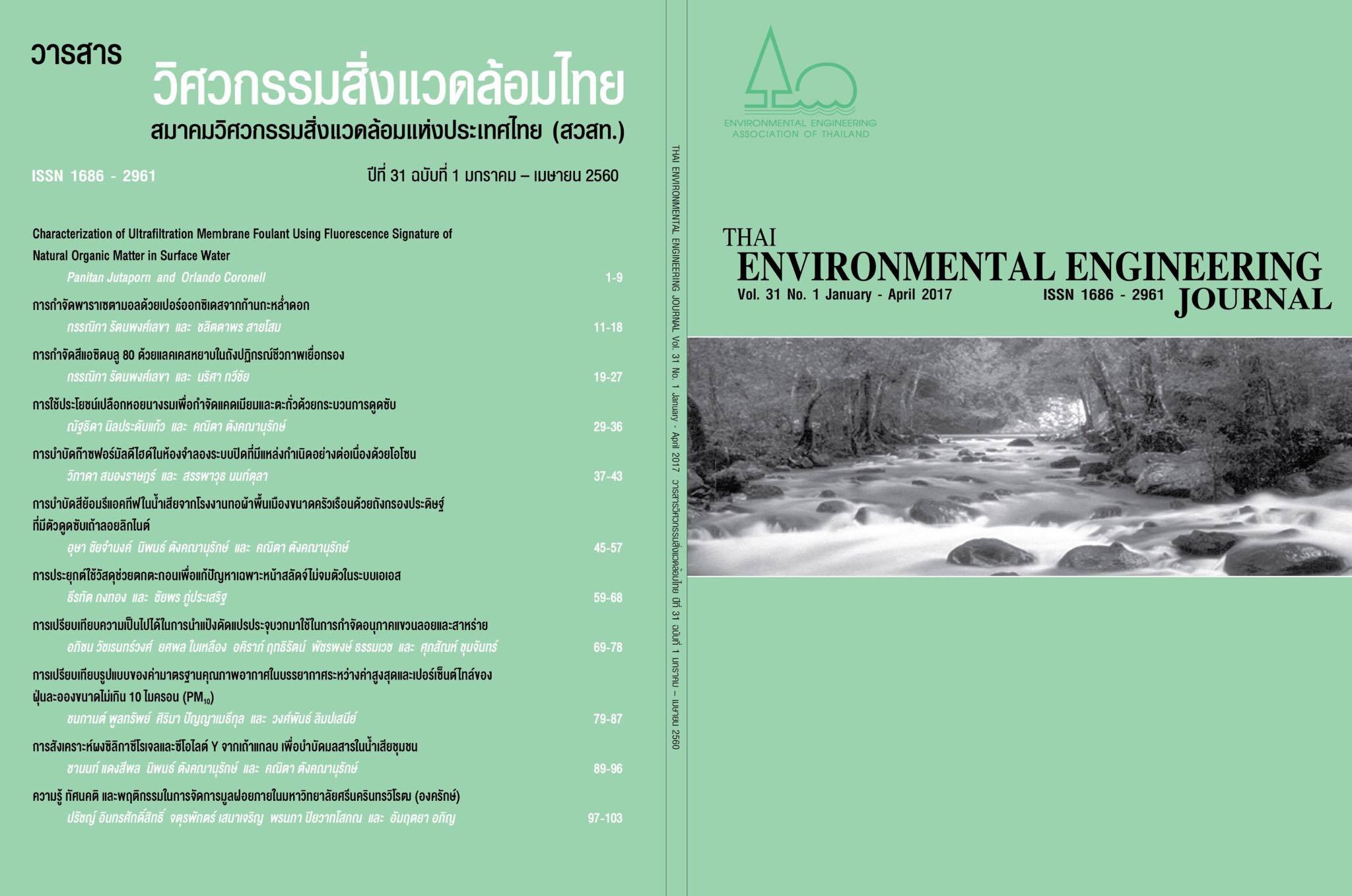Comparing the Possibility of using Cationic Starch for Removal of Suspended Particles and Algae
Main Article Content
Abstract
Chemical substances are currently used as coagulants to improve water quality through a water treatment with coagulation and disinfection processes. However, it is concerned that the residue resulted from the reaction of chemicals can cause toxicity for human health when being exposed. Thus, it is important to study the possibility of using organic coagulants in the water supply treatment for removing suspended particles in the raw water. This research was to conduct the feasibility study of comparing organic coagulants such as cationic starch, alginate and bagasse ash to improve the raw water quality. The results showed that the cationic starch was more effective in comparison to other organic coagulants for the synthetic water. The cationic starch was introduced to study the removal of suspended particles and algae by comparing with the coagulation agent, PAC: Polymer. In this studies, 0.4 g : 0.02 g of PAC:Polymer ratio was used and was controlled at pH 10, whereas 0.85 g of cation starch was used and was controlled at pH 10. Higher removal efficiency of suspended particles in the raw water was observed for PAC: Polymer, but the cationic starch exhibited higher algae removal. The density of algae in the raw water may significantly affect the efficiency of turbidity and algae removal because algae can suspend in the water, implying both roles as suspended particles and turbidity.
Article Details
References
[2] J.R. Walton. 2012. Alumium Disruption of Calcium Homeostasis and Signal Transduction Resembles Change that Occurs in Aging and Alzheimer’s Disease. Journal of Alzheimer’s Disease. 29: 255-273.
[3] Pinthita Mungkarndee. 1988. using Moringa seed for removal of turbidity in water. KKU Engineering Journal. 15(2): 39-43. (in Thai)
[4] Soydoa Vinitnantharat. 2015. The Use of Fruit Seeds as Coagulant and Coagulant Aid. Bangkok, King Mongkut's University of Technology Thonburi, Thailand. (in Thai)
[5] Ratikorn Sanghaw. 2003. The Use of plant Seeds as Coagulant and Coagulant Aid. Bangkok, King Mongkut's University of Technology Thonburi, Thailand. (in Thai)
[6] Yotsawadee Arunrat. 2013. Utilization of Extracted Moringa Oleifera Leave and Seed Mixtures for Turbidity Removal from Pickled Mustard Greens Factory Wastewater. Environmental Health Journal. 16(1) (October-December): 35-47. (in Thai)
[7] Rungthiwa Naveesathien. 2013. Pickled Mustard Greens Factory Wastewater Treatment by Utilizing Extracted Moringa Oleifera Seed as Coagulant. Environmetal Health Journal. 16(1) (October-December): 14-22. (in Thai)
[8] Pingorn Wiliwong. 2002. Preparation of coagulant from industrial solid waste for wastewater treatment. Bangkok, Chulalongkorn University, Thailand. (in Thai)
[9] Dries Vandamme, Imogen Foubert, Boudewijn Meesschaert, Koenraad Muylaert. 2010. Flocculantion of microalgae using cationic starch. J. Appl. Phycol. 22: 525-530.
[10] H. Aylin Devrimci, H., Mete Yuksel, A. and Dilek Sannin, F. 2012. Algal alginate: A potential coagulant for drinking water treatment, Desalination. 299: 16-21.
[11] Katesarin Vorradetwittaya. 2009. Turbidity and algae removal from water by chemical coagulation. Bangkok, Chulalongkorn University, Thailand. (in Thai)
[12] Jin Li, Shufang Jiao, Lian Zhong, Jinfen Pan and Qimin M. 2013. Optimizing coagulation and flocculation process for kaolinite suspension with chitosan, Colloid Surfaces A. 428: 100-110.
[13] V. Kothandaraman and Ralph L. Evans. 1972. Removal of algae from waste stabilization pond effluents - A state of the art, state of Ilinois department of registration and education, Illinois state water survey Urbana, 1-9.
[14] Jiexia Liu, Yi Zhu, Yujun Tao, Yuanming Zhang, Aifen Li, Tao Li, Ming Sang, Chengwu Zhang. 2013. Frechwater microalgae harvested via flocculation induced by pH decrease, Biotechnology for Biofuels, 1-11.


